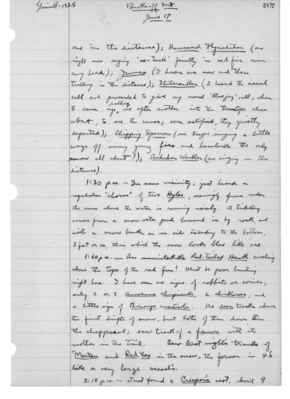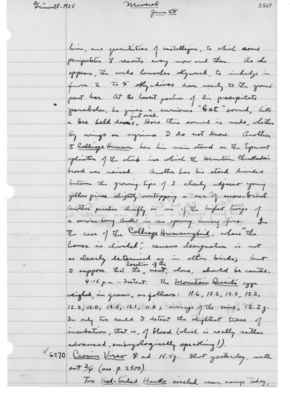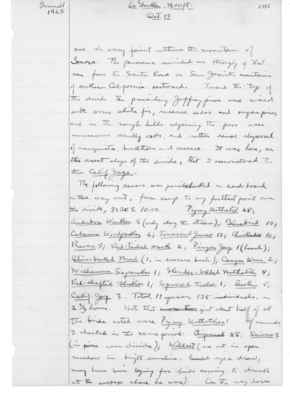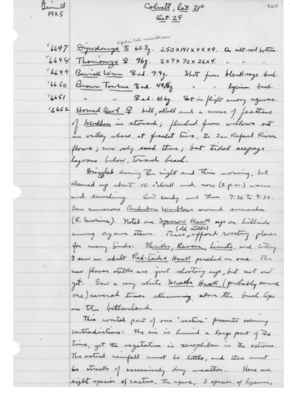Pages That Mention Red-Tailed Hawk
1925: Joseph Grinnell's field notes
S2 Page 17
Collector: Grinnell - 1925 Location: Lassen Section (Brokeoff Mt.) Date: June 17, 1925 Page Number: 2472
one in the distance); Hammond Flycatcher (one right now saying "see-Tuck" faintly in red fir over my head); Junco (I hear one now and then trilling in the distance); Nutcracker (I heard the nasal call and proceeded to give my usual "bluejay" call, when 5 came up, calling, one after another into the treetops close about, to see the cause; soon satisfied, they quietly departed); Chipping Sparrow (one keeps singing a little way off away young firs and hemlocks the only snow all about!); Audubon Warbler (one singing in the distance). 1:30 p.m. - In same vicinity; just heard a regulation "chorus" of two Hylas, seemingly from under the snow where the water is running noisily. A tributary comes from a snow-water pond hemmed in by rock, and with a snow bank on one side extending to the bottom, 3 feet or so, thru which the snow looks blue like ice. 1:50 p.m. - An unmistakable Red-Tailed Hawk circling above the tops of the red firs! Must be poor hunting right here. I have seen no signs of rabbits or conies; only 2 or 3 Amoenus Chipmunk, 2 chickadees, and a little sign of Thomomys monticola. No deer tracks above the first drifts of snow, but lots of them down thru the chaparral; saw track of a fawn with its mother in the trail. Saw last night's tracks of Marten and Red Fox in the snow, the former in 4's like a very large weasel's. 2:15 p.m. - Just found a Creeper's nest, about 9
S2 Page 53
Collector: Grinnell - 1925 Location: Mineral Date: June 28 Page Number: 2507
him, are quantities of castillejas, to which some peripatetic [female symbol] resorts every now and then. As she appears, the male launches skyward, to indulge in from 2 to 5 sky-dives down nearly to the ground past her. At the lowest portion of this precipitate parabola, he gives a curious "bzt" sound, like a bee held down, ^just once. How the sound is made, whether by wings or syrinx I do not know. Another [male symbol] Calliope Hummer has his main stand on the tipmost splinter of the stub in which the Mountain Chickadee's brood was raised. Another has his stand divided between the growing tips of 3 closely adjacent young yellow pines slightly overtopping a sea of snow-brush. Another perches chiefly on one of the highest twigs of a service-berry thicket in an opening among firs. In the case of the Calliope Hummingbird, where "the house is divided," census designation is not as clearly determined as in other birds; but I suppose that the ^location of the nest, alone, should be counted.
4:15 p.m. - Intent. The Mountain Quail's eggs weighed, in grams, as follows: 11.6, 12.2, 12.3, 13.2, 12.2, 12.0, 12.5, 12.1, 11.4; average of the nine, 12.2 g. In only two could I detect the slightest trace of incubation, that is, of blood (which is really rather advanced, embryonically speaking!).
6270 Cassin Vireo [female symbol] ad. 15.5 g. Shot yesterday, with set 2/4 (see p. 2500).
Two Red-Tailed Hawks circled near camp today,
S3 Page 43
Collector: Grinnell - 1925 Location: La Grulla, 7200 ft. Date: Oct. 13 Page Number: 2586
see in very faint outline the mountains of Sonora. The panorama reminded me strongly of that seen from the Santa Rosa or San Jacinto mountains of southern California eastward. Toward the top of the divide the prevailing Jeffrey pines were mixed with some white fir, incense cedar and sugar pine; and in the rough hills adjoining the pass were numerous scrubby oaks, and rather dense chaparral of manzanita, buckthorn, and cascara. It was here, on the dessert slope of the divide, that I encountered the three Calif. Jays. The following census was pencil checked on card-board on the way out, from camp to my farthest point over the divide, 7:20 to 10:00. Pigmy Nuthatch 68; Audubon Warbler 5 (only along the stream); Bluebird 10; Cabanis Woodpecker 6; Townsend Junco 13; Chickadee 10; Raven 5; Red-tailed Hawk 2; Pinyon Jay 1 (heard); Olive-backed Thrush (1, in cascara bush); Canyon Wren 2; Williamson Sapsucker 1; Slender-billed Nuthatch 4; Red-shafted Flicker 1; Spurred Towhee 1; Siskin 5; Calif. Jay 3. Total, 17 species, 138 individuals, in 2 2/3 hours. Note that just about half of all the birds noted were Pigmy Nuthatches! Of mammals I checked in the same period; Chipmunk 28;Scirus 2 (in pine near divide); Wildcat (one out in open meadow in bight sunshine; bounded up a draw; may have been laying for birds coming to drink at the seepage near where he was); on the way down
S3 Page 68
Collector: Grinnell - 1925 Location: Colnett, Sat. 31 degrees Date: October 29, 1925 Page Number: 2610
6647 Dipodomys (male sign) 60.3g. 250 x 141 x 42 x 9. On silt-soil bottom. 6648 Thomomys (female sign) 96g. 207 x 70 x 26 x 4. “ “ “ 6649 Bewick Wren (female sign) ad. 9.9g. Shot from black-sage bush. 6650 Brown Towhee (male sign) ad. 44.5g “ “ lycium bush. 6651 “ “ (female sign) ad. 41.6g. Shot in flight among agaves. 6652 Horned Owl (female sign) bill, skull and a mass of feathers of Mudhen in stomach; flushed from willows out in valley where, at freshet time, the San Rafael River flows; now only sand there; but tidal seepage lagoons below, toward beach.
Drizzled during the night and this morning, but cleared up about 10 o’clock and now (2 p.m.) warm and sunshiny. Out early and then 7:30 to 9:30. Saw numerous Audubon Warblers around sumachs (R. laurina). Noted one Sparrow Hawk up on hillside among agave stems. These (old stalks) afford roosting places for many birds: Shrikes Ravens, Linnets, and today I saw an adult Red-Tailed Hawk perched on one. The new flower stalks are just shooting up, but not out yet. Saw a very white Marsh Hawk (probably same one) several times skimming above the bush tops on the bottomland. The coastal part of our “section” presents seeming contradictions: the air is humid a large part of the time, yet the vegetation is xerophilous in the extreme. The actual rainfall must be little, and there must be streaks of excessively dry weather. Here are eight species of cactus, the agave, 3 species of lycium,



